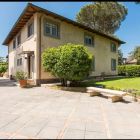A showcase of British culture
Anyone who has lived long enough in Rome will remember the days when the British Council was a somewhat stuffy institution, frequented mostly by that stratum of the ex-pat community commonly referred to as the ladies in hats. This summer, as I stepped over the threshold of the historic premises in Palazzo del Drago on Via delle Quattro Fontane, I couldnt help wondering what these ladies would have thought today, finding themselves confronted with an exhibition of Julian Germains photos of the Nick Kidney models of subbuteo superheroes, in the guise of cartoon characters including Batman, Superman and Spiderman. They would probably have been even more dumbfounded at the sight of a couple of subbuteo tables, set up for an in-house competition among British Council language students.
This all comes from Naples, where we recently ran an activity workshop in the new science centre, the Citt della Scienza, explained Brendan Griggs, director of the British Council arts programme for Italy. It was a great success. Lots of children came and rediscovered this game. Subbuteo was a 1970s phenomenon, which is now enjoying a revival.
Events aimed at involving the younger generation are only the latest in a series of imaginative initiatives launched by the council over the last decade, as it seeks to widen Italian perception of British culture.
In February, we ran a jazz dance workshop for school children in Brescia with the Bullies Ballerinas group. Theyre a company of UK dancers who come from a range of ethnic backgrounds. Brescia has a very high immigrant population and the aim of the exercise was to favour cultural integration. The dancers and the children didnt speak each others languages and they learned to communicate through movement and body language.
During the 11 years that Griggs has spearheaded the councils cultural programme, his quiet determination has brought about a revolution. The classic image of British culture, centred around Shakespeare and a few big-name writers, has gradually been replaced with a more modern and realistic view of a vibrant, multi-ethnic society, open to experimentation and innovation. While the public continues to identify the British Council most closely with its long-standing programme of visiting writers and poets (in Rome, this is now run in collaboration with the Keats Shelley Memorial House), the range of cultural activities enjoying council patronage has expanded to cover practically every field of the visual and performing arts.
In addition, the council now tends to work more and more closely with Italian local authorities. A lot of our initiatives are centred in Lombardy and Naples partly because we have centres there but well go wherever local and regional governments are interested in our approach. Rome gives us very generous sponsorship, and allowing us the use of premises such as Palazzo delle Esposizioni has given us access to a much wider public. At the moment, were studying ways our aims can combine with those of the city council, such as presenting little-known names alongside big ones. What were really interested in is launching new artists and performers who can convey an idea of modern cultural trends in the UK today.
Of course, we also continue to do the more traditional things, like last seasons King Lear at Teatro Valle, but we did feel that British theatre in Italy was somewhat stuck in the Pinter/Stoppard period. We therefore decided that we would promote contemporary British drama by having it translated into Italian.
This developed into TREND, new frontiers of British theatre, an annual showcase of new plays currently running in the UK, presented at Teatro Belli in Rome and performed by various young companies from different parts of Italy. Now into its third edition, the programme has proved very popular, especially with young audiences.
Events in 2002 involving British participation include the Turin Young Art Biennial, an acoustics roadworks tour in Brescia, Pesaro, Bologna and Bolzano, and a dance festival in Milan, and the Foreign Office Architects group is currently exhibiting its work at the Venice Architecture Biennial.
However, the councils voice is probably most incisive behind the scenes.
Theres a lot of work the public doesnt see, Griggs explained. For the past eight years, weve been organising showcases in the UK, where we send promoters and motivators from the Italian arts world. The Italians are our guests for four or five days, during which we introduce them to a selection of companies doing interesting and challenging work suitable for an international audience. In 2000 we organised 11 professional visits which led to 26 engagements in the following 15 months.
Recently, however, the council has had to cope with the new and worrying obstacle of double taxation, as Griggs wryly explained:Until recently, British companies performing in Italy didnt pay tax on fees because of a double taxation agreement. Now, however, Italys finance minister is demanding a 30 per cent tax on fees at source. Its true that fees tax can be reclaimed in the UK, but there it is only 22 per cent. This means groups are 8 per cent out of pocket, and theyre being forced to put up their fees to compensate. This is very serious for orchestras, which have charity status in the UK and therefore dont pay tax. Part of our job is also lobbying against this kind of thing.
A special treat awaits Rome audiences this autumn (2002), when the British Council launches its extra special Hot October programme a crammed calendar of creative events. For information tel. 06478141.





















